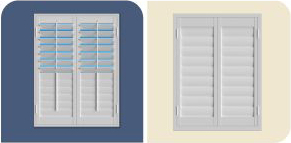
3 Ways Polywood Shutters Are Preferred Over Hollow Vinyl And Composite Shutters In Austin, TX
December 15, 2015
Wherever you look in Austin, there are plenty of plantation shutters choices. And when you want to know which non-wood shutter fits your home best, it’s not easy to distinguish the differences. You can unknowingly choose the wrong type and wind up investing in shutters that won’t last. When it comes to solid polymer shutters, like our best-selling Polywood® shutters, are they worth more than composite shutters? Learn about the three ways Polywood shutters are preferred over composite shutters in Austin, TX to help you decide.
1. Polywood vs Composite Shutters Durability
Polywood shutters are constructed from high quality solid polymer that results in the most color-retention, durability, and rigidity than any other shutter available. This means the shutter louvers won’t warp as long as they’re on the window. On the other hand, composite shutters are constructed from a pressed-board core, enveloped in poly-vinyl. The vinyl wrapping the pressed board also peels away from the core element readily. And this peeling happens even faster in humid, wet, and hot surroundings. Hollow vinyl shutters are another option for non-wood shutters. But they degrade the fastest due to the substance.Both forms of non-wood shutters are susceptible to deterioration and warping under varying weather conditions in Austin. Polywood is built with UV inhibitors that divert heat. And since heat is the biggest culprit in warping the shutter louvers, Polywood is absolutely the highest quality plantation shutter you can find.
2. Polywood vs Composite Shutters Color Fastness
Polywood shutters come in three superior white paints. These paint finishes are baked on each component at hot temperatures that exceed any temperatures Austin could experience. Our patented finishing process applies UV inhibitors and ensures the color will never fade.
Other types of non-wood shutters come with either low quality paint finish or no paint finish at all. In most cases, the vinyl covering is the all the color you get. This finish may look good initially, but it fades as time goes by. And as to hollow vinyls, some are painted. With the vinyl being a heat conductor, this seriously impacts the finish as time goes by.
3. Polywood vs Composite Shutters Energy Efficiency
Third party testing illustrates that Polywood shutters block up to 30° of temperature and result in a reduction of heat transfer by up to 45%. This means that Polywood insulates up to 70% better than a similar solid wood shutter.
These insulating properties are due to the solid polymer material Polywood shutters are made from. But what makes Polywood even more energy efficient than composite shutters is the weatherstripping on the panels and louvers. All you have to do is interlock the weatherstripping while closing the panels. This gives you a very tight seal against the effects of the weather outside. You won’t find all the energy savings that Polywood offers in any composite shutter.
Our Team In Vegas’s First Hand Experience With The Durability Of Polywood Shutters
In 2004, Sunburst Shutters Las Vegas had Polywood shutters fastened to the sides of their trucks as part of the graphics. They were parked outside and saw all the weather conditions Nevada is known for. That’s intense heat for almost five months each year!
These shutters had been fastened to our vehicles for more than 7 years. That’s when our team conducted an experiment on how well Polywood retained the color painted on it. We dusted off the Polywood shutter that was on the truck. And we brought a new Polywood shutter and held it up next to it to compare. We found the color to be unchanged. There was no fading or discoloration. It was further validation for our team that the Sunburst paint finish is indeed the best around!
And with Polywood withstanding all that heat and abuse travelling on a truck for over 7 years, it’s without a doubt the strongest shutter for your residence in Austin, TX.


